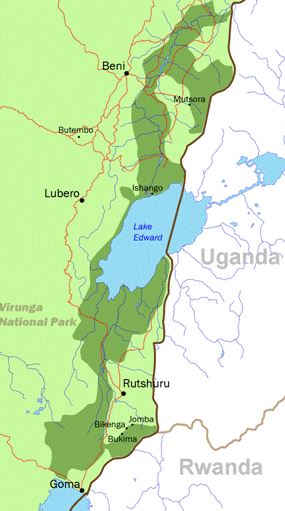At just over 3,000 square miles (7,800 km2), Virunga NP is not the largest Park in DR Congo but in comparison to UK National Parks, it is massive. It is over twice the size of the county of Cornwall, UK.

It stretches from close to Goma in the south, bordering Rwanda in the east and up to the Ruhenzori mountains in the north (on the border with Uganda).
In the centre, is Lake Edward. Virunga is Africa’s most biologically diverse protected area and became a UNESCO World Heritage Site in 1979. Due to major insecurity during the Great Lakes conflict, it was listed as a ‘World Heritage Site – in Danger’ in 1994.
Virunga has southern, central and northern sectors, with a main ranger station in each. Mutsora in the north, Rwindi in the central sector and Rumangabo in the south, also serving as the National Park Headquarters.
Virunga is not only the oldest National Park in Africa, it’s also the second oldest National Park in the world, only behind America’s Yellowstone NP.
Despite this, the forests and amazing animals of the park, most notably the mountain gorilla, are in a desperate fight for their survival.
The light green area is the Mikeno gorilla sector with smaller patrol stations marked: Kibumba, Gatovu, Bukima, Bikenge and Jomba.
Wildlife & Biodiversity
Virunga NP is truly the crown jewel of Africa’s Parks. The 8,000 km2 Park contains over 50% of sub-Saharan Africa’s biodiversity and is home to over a quarter of the earth’s last 880 critically endangered mountain gorillas.
Along with the mountain gorilla, Virunga is also home to the golden monkey, Rwenzori duiker, Rwenzori otter shrew, elephant, hippo, the large Rwenzori Tauraco and rare chameleon.

Virunga plays host to more bird (706) and mammal (196) species than any other Park in Africa and contains 109 reptile, 78 amphibian and an estimated 2,077 plant species. These are dispersed throughout its amazing variety of habitats: lowland forest, wetlands, lava fields, savannah, bamboo, montane forests and the Rwenzori glaciers, up in the far north.


Lake Edward, in the centre of the Park, is a very large and productive lake, renowned for its tilapia fish. For many years it was famous for its influx of migratory bird species and was subject to much research.
Unfortunately, Lake Edward was the scene of the slaughter of many, many hundreds of hippo by Mai Mai rebels in 2007, in search of ivory from their incisor teeth and meat.
Virunga once had the largest concentration of hippo in the world, numbering well over 200,000 thirty years ago.
There were just an estimated 300 or so remaining in and around Lake Edward but their numbers are slowly recovering.
Mt Nyiragongo
Of all the volcanoes in the extensive ‘Virunga Massif’ area (some shared by DR Congo, Rwanda and Uganda) the two that are still active lie within Virunga NP southern sector; Nyamulagira and Nyiragongo.

The latter erupted violently in 2002, swamping a fifth of the city of Goma and some of the Park and rendering 120,000 people homeless.
Nyiragongo has the largest lava lake in world. At an altitude of 3,470m, it is 250m deep and the bubbling, white hot lake is 2kms wide.
For well over a decade, Virunga NP has faced, and continues to be threatened by, illegal settlement, agriculture and fishing, the presence of various armed militia and the military.
Basic human demands for land, food and fuel has led to encroachment into the Park, a massive demand for charcoal for cooking and heating and poaching for bushmeat.
The city of Goma, a short distance from the southern Park boundary has around 2+million inhabitants. The demand for charcoal is appears insatiable and drives the illegal charcoal burning trade, the single biggest threat to the mountain gorillas.
Park Management
The Park is managed by the Institut Congolais pour la Conservation de la Nature (ICCN), with Dr Emmanuel de Merode as its Director, since August 2008.
The Director has around 650 rangers stationed throughout the Park, more than in any other ICCN Protected Area. In trying to combat the threats to the Parks future, the past decade has seen over 150 rangers lose their lives in the line of duty.

Virunga NP is managed in three sections, each with its own main ranger station. Many smaller, satellite patrol posts provide the bases from which rangers operate on a daily basis. Rangers are rotated around these patrol posts and also the different sectors, to gain experience within different areas of the Park.

Mutsora station, in the northern sector, sits on the lower flanks of the Ruhenzori mountain range, bordering Uganda.
Further south, Rwindi is the main central sector station, positioned in the vast savannah plains, with big, open skies.
Rumangabo provides the southern sector base and is also HQ for the Park as a whole. The Mikeno gorilla sector is within this southern area of Virunga NP, mainly bordering Rwanda, but also Uganda.
With all the challenges that face Virunga NP, it is a World Heritage Site in need of the very highest level of protection and assistance.
It is not just a totally unique natural resource that will help bring revenue to the country as a whole and especially the local communities of the area, when visitors can once again marvel at what it has to offer; it is not just the home of 200+ of the worlds critically endangered mountain gorillas, nor just the home for many other endangered or endemic species that survive nowhere else; it is not just a jewel of DR Congo….
The Park Director, rangers and all the Parks many conservation partners, work desperately hard to protect this stunning National Park and its wildlife, on behalf of the world community too. It is the responsibility of all of us, across the globe, to help protect and conserve this unique ‘World Heritage Site – in Danger’.


